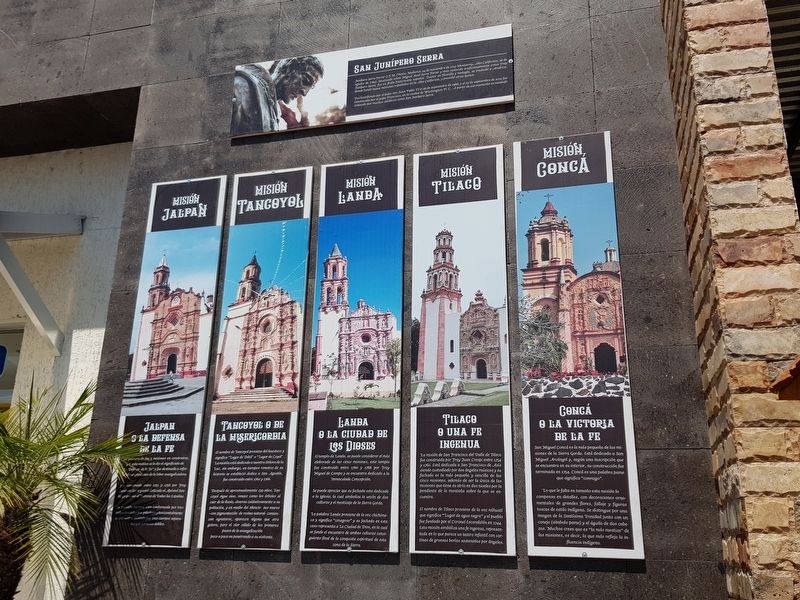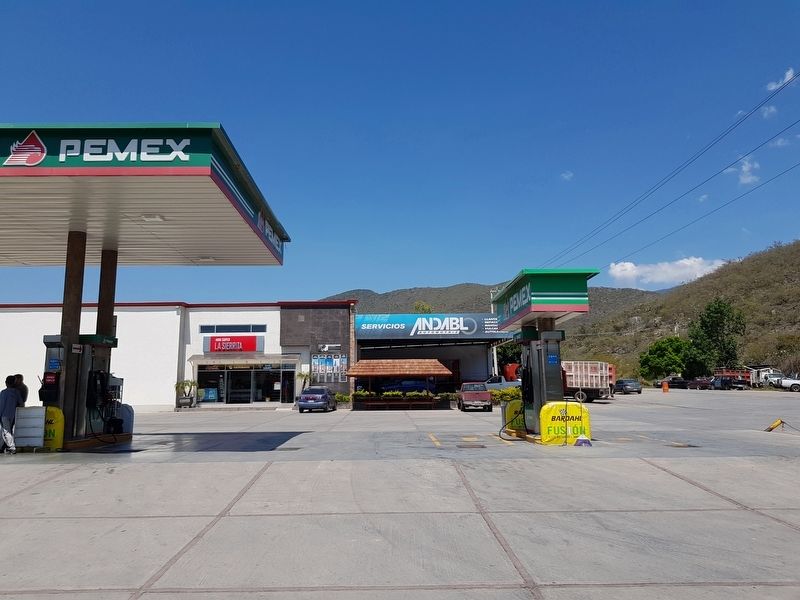Near La Vuelta in Landa de Matamoros, Querétaro, Mexico — The Central Highlands (North America)
Saint Junípero Serra and the Five Sierra Gorda Missions
Inscription.
San Junípero Serra
Junípero Serra Ferrer O.F.M. (Petra, Mallorca; 24 de noviembre de 1713 – Monterrey, Alta California; 28 de agosto de 1784), bautizado como Miguel José Serra Ferrer y más conocido tradicionalmente como Fray Junípero Serra, fue un fraile franciscano español. Doctor en filosofía y teología, se trasladó a América, donde fundó nueve misiones españolas en la Alta California, y presidió otras quince.
Fue beatificado por el papa San Juan Pablo II el 28 de septiembre de 1988, y el 23 de septiembre de 2015 fue canonizado por el papa Francisco, en la ciudad de Washington D.C. A partir de ese momento es también conocido por muchos católicos como San Junípero Serra.
Misión Jalpan
Jalpan o la Defensa de la Fe
Fue la primera de las 5 misiones en construirse, por lo cual se le dio el significado de “La Defensa de la Fe” y fue destinada a reforzar el cumplimiento de la labor evangelizadora.
Fue construido entre 1751 y 1758 por Fray Junípero Serra y está dedicada al Apóstol Santiago por ser el Patrono de Todas las Españas.
Su portada barroca esta conformada por tres calles divididas por pilastras y horizontalmente se encuentra dividida por tres cuerpos separados por cornisas dobles.
Misión Tancoyol
Tancoyol o de la Misericordia
El nombre de Tancoyol proviene del huasteco y significa “Lugar de Dátil” o “Lugar de Coyol”. La misión está dedicada a nuestra Señora de la Luz, sin embargo, en tiempos remotos de su historia se estableció dedica a San Agustín, fue construida entre 1760 y 1766.
Después de aproximadamente 239 años, Tancoyol sigue vivo, renace como los árboles al caer de la lluvia, observa cuidadosamente a su población, y en medio del silencio sus muros – con pigmentación de resina natural – comienzan agrietarse, aparecen alguna que otra gotera, pero el olor cálido de los primeros pasos de la evangelización poco a poco va penetrando a su visitante.
Misión Landa
Landa o la Ciudad de los Dioses
El templo de Landa, se puede considerar el más elaborado de las cinco misiones, este templo fue construido entre 1760 y 1768 por Fray Miguel de Campa y se encuentra dedicado a la Inmaculada Concepción.
Se puede apreciar que su fachada esta dedicada a la iglesia, la cual simboliza la unión de dos culturas y el mestizage de la Sierra Gorda.
La palabra Landa proviene de la voz chichimeca y significa “cenegoso” y su fachada en este
caso representa a La Ciudad de Dios, en la cual se funde el encuentro de ambas culturas consiguiente final de la conquista espiritual de esta zona de la Sierra.
Misión Tilaco
Tilaco o una Fe Ingenua
La misión de San Francisco del Valle de Tilaco fue construida por Fray Juan Crespi entre 1754 y 1762. Está dedicada a San Francisco de Asís siendo custodiado por dos angeles músicos y sus fachada es la má pequeña y sencilla de las cinco misiones, además de ser la única de las misiones que tiene su atrio en dos niveles por la pendiente de la montaña sobre la que se encuentra.
El nombre de Tilaco proviene de la voz náhuatl que significa “Luga de agua negra” y el pueblo fue fundado por el Coronel Escandalón en 1744. Esta misión simboliza una fe ingenua, representada en lo que parece un teatro infantil con cortinas de gruesas borlas sostenidas por ángeles.
Misión Concá
Concá o la Victoria de la Fe
San Miguel Concá es la más pequeña de las misiones de la Sierra Gorda. Está dedicada a San Miguel Arcángel y, según una inscripción que se encuentra en su interior, su construcción fue terminada en 1754. Concá es una palabra pame que significa “conmigo”.
Lo que falta en tamaño esta misión lo compensa en detalles, con decoraciones ornamentales de grandes flores, follage y figuras toscas de estilo indígena. Se distingue por una imagen de la Santísima Trinidad junto con un conejo (símbolo pame) y el águila de dos cabezas. Muchos creen que es “la más mestiza” de las misiones, es decir, la que más refleja la influencia indígena.
Saint Junípero Serra
Junípero Serra Ferrer O.F.M. (Petra, Mallorca; November 24, 1713 - Monterrey, Alta California; August 28, 1784), baptized as Miguel José Serra Ferrer and more traditionally known as Friar Junípero Serra, was a Spanish Franciscan friar. A doctor in philosophy and theology, he moved to America, where he founded nine Spanish missions in Alta California, and presided over another fifteen.
He was beatified by Pope Saint John Paul II on September 28, 1988, and on September 23, 2015 he was canonized by Pope Francis, in the city of Washington D.C. From that moment on, he is also known by many Catholics as Saint Junípero Serra.
The Jalpan Mission
Jalpan or the Defense of the Faith
This was the first of the five missions to be built, which is why it was given the name of “The Defense of the Faith ”and was destined to reinforce the fulfillment of spreading the gospel.
It was built between 1751 and 1758 by Friar Junípero Serra and is dedicated to the Apostle Saint James (Santiago) for being the Patron Saint of All Spain.
Its baroque façade is made up of three vertical sections divided by pilasters. Horizontally it is also divided by three sections separated by double cornices.
The Tancoyol Mission
Tancoyol or Mercy
The name of Tancoyol comes from Huasteco and means "Place of the Dates" or "Place of the Coyol". The mission is dedicated to Our Lady of Light, however, in remote times in its history it was dedicated to Saint Augustine. It was built between 1760 and 1766.
After approximately 239 years, Tancoyol is still alive - it is reborn like the trees that flower with new rains. It carefully observes its people, and in the middle of its silence its walls – painted with natural resin pigmentation - begin to crack and the occasional leak appears, but the warm smell of the first steps of evangelization little by little enters the senses of the visitor.
The Mission at Landa
Landa or the City of the Gods
The temple of Landa can be considered the most elaborate of the five missions. This temple was built between 1760 and 1768 by Friar Miguel de Campa and is dedicated to the Immaculate Conception.
It can be seen that its facade is dedicated to the church, which symbolizes the union of two cultures here in the Sierra Gorda.
The word Landa comes from the Chichimeca language and means "blind". Its facade in this case represents The City of God, in which the meeting of both cultures is founded and leading eventually to the spiritual conquest of this part of the Sierra.
The Tilaco Mission
Tilaco or a Naive Faith
The mission of San Francisco del Valle de Tilaco was built by Friar Juan Crespi between 1754 and 1762. It is dedicated to San Francisco de Asís, who is guarded by two musician angels. Its façades is the smallest and simplest of the five missions, as well as being the only one of the missions that has its atrium on two levels due to the slope of the hill on which it is located. Its façade by two musician angels and their façades,
The name of Tilaco comes from Nahuatl and means "place of the black water" and the town was founded by Colonel Escandalón in 1744. This mission symbolizes a naive faith, represented by what appears to be a children's theater with curtains with thick tassels held up by angels.
The Concá Mission
Concá or the Victory of the Faith
San Miguel Concá is the smallest of the Sierra Gorda missions. It is dedicated to Saint Michael the Archangel and, according to an inscription found inside, its construction was completed in 1754. Concá is a Pame word that means “with me”.
What this mission lacks in size, it makes up for in details, with ornamental decorations of large flowers, foliage and bold indigenous-style figures. It is distinguished by an image of the Holy Trinity along with a rabbit (a Pame symbol) and the two-headed eagle. Many believe that it is "the most mestizo" of the missions, that is, the one that most reflects indigenous influence.
Topics. This historical marker is listed in these topic lists: Churches & Religion • Colonial Era. A significant historical date for this entry is August 28, 1713.
Location. 21° 16.773′ N, 99° 14.96′ W. Marker is near La Vuelta, Querétaro, in Landa de Matamoros. Marker is at the intersection of Querétaro Route 120 and Querétaro Route 190, on the right when traveling south on State Route 120. Touch for map. Marker is in this post office area: La Vuelta QUE 76382, Mexico. Touch for directions.
Other nearby markers. At least 8 other markers are within 21 kilometers of this marker, measured as the crow flies. 250th Anniversary of the Founding of the Mission at Landa de Matamoros (approx. 13 kilometers away); Santa María del Agua de Landa Franciscan Mission (approx. 13 kilometers away); Tribute to Benito Juárez (approx. 13.1 kilometers away); 250th Anniversary of the Founding of the Mission at Tilaco (approx. 14.2 kilometers away); San Francisco de Tilaco Franciscan Mission (approx. 14.2 kilometers away); Nuestra Señora de la Luz de Tancoyol Franciscan Mission (approx. 15.7 kilometers away); 250th Anniversary of the Founding of the Mission at Tancoyol (approx. 15.7 kilometers away); The Building of the Attached Room (approx. 20.2 kilometers away).
Credits. This page was last revised on March 20, 2020. It was originally submitted on March 20, 2020, by J. Makali Bruton of Accra, Ghana. This page has been viewed 122 times since then and 13 times this year. Photos: 1, 2. submitted on March 20, 2020, by J. Makali Bruton of Accra, Ghana.

